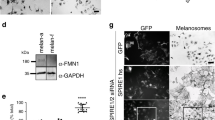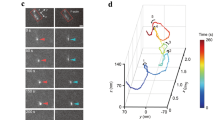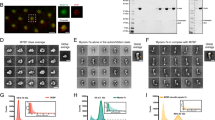Abstract
STUDIES of organelle movement in axoplasm extruded from the squid giant axon have led to the basic discoveries of microtubule-dependent organelle motility1–3 and the characterization of the microtubule-based motor proteins kinesin and cytoplasmic dynein4,5. Rapid organelle movement in higher animal cells, especially in ,neurons, is considered to be microtubule-based. The role of actin filaments, which are also abundant in axonal cytoplasm6,7, has remained unclear. The inhibition of organelle movement in axoplasm by actin-binding proteins8–11 such as DNase I, gelsolin and synapsin I has been attributed to their ability to disorganize the microtubule domains where most of the actin-fi laments are located7. Here we provide evidence of a new type of organelle movement in squid axoplasm which is independent of both microtubules and microtubule-based motors. This movement is ATP-dependent, unidirectional, actin-dependent, and probably generated by a myosin-like motor. These results demonstrate that an actomyosin-like mechanism can be directly involved in the generation of rapid organelle transport in nerve cells.
This is a preview of subscription content, access via your institution
Access options
Subscribe to this journal
Receive 51 print issues and online access
$199.00 per year
only $3.90 per issue
Buy this article
- Purchase on Springer Link
- Instant access to full article PDF
Prices may be subject to local taxes which are calculated during checkout
Similar content being viewed by others
References
Allen, R. D., Metuzals, J., Tasaki, I., Brady, S. T. & Gilbert, S. P. Science 218, 1127–1128 (1982).
Allen, R. D. et al. J. Cell Biol. 100, 1736–1752 (1985).
Weiss, D. G., Langford, G. M., Seitz-Tutter, D. & Keller, F. Cell. Motil. Cytoskel. 10, 285–295 (1988).
Vale, R. D., Reese, T. S. & Sheetz, M. P. Cell 42, 39–50 (1985).
Gilbert, S. P. & Sloboda, R. D. J. Cell Biol. 109, 2379–2394 (1989).
Morris, J. R. & Lasek, R. J. J. Cell Biol. 98, 2064–2076 (1984).
Fath, K. R. & Lasek, R. J. J. Cell Biol. 107, 613–621 (1988).
Goldberg, D. J., Harris, D. A., Lubit, B. W. & Schwartz, J. H. Proc. natn. Acad. Sci. U.S.A. 77, 7448–7452 (1980).
Isenberg, G., Schubert, P. & Kreutzberg, G. W. Brain Res. 194, 588–593 (1980).
Brady, S. T., Lasek, R. J., Allen, R. D., Yin, H. L. & Stossel, T. P. Nature 310, 56–58 (1984).
McGuinness, T. L. et al. J. Neurosci. 9, 4138–4149 (1989).
Wulf, E., Deboben, A., Bautz, F. A., Faulstich, H. & Wieland, T. Proc. natn. Acad. Sci. U.S.A. 76, 4498–4502 (1979).
Weiss, D. G. J. Cell Sci. S5, 1–15 (1986).
Estes, J. E., Selden, L. A. & Gershman, L. C. Biochemistry 20, 708–712 (1981).
Maclean-Fletcher, S. & Pollard, T. D. Cell 20, 329–341 (1980).
West, J. J., Nagy, B. & Gergely, J. J. biol. Chem. 242, 1140–1145 (1967).
West, J. J., Nagy, B. & Gergely, J. Biochem. biophys. Res. Commun. 29, 611–616 (1967)
Caldwell, P. C. J. Physiol. 152, 561–590 (1960).
Kron, S. J. & Spudich, J. A. Proc. natn. Acad. Sci. U.S.A. 83, 6272–6276 (1986).
Schnapp, B. J., Vale, R. D., Sheetz, M. P. & Reese, T. S., Cell 40, 455–462 (1985).
Hoebeke, J., Van Nijen, G. & De Brabander, M. Biochem. biophys. Res. Commun. 69, 319–324 (1976).
Cohn, S. A., Ingold, A. L. & Scholey, J. M. Nature 328, 160–163 (1987).
Gibbons, I. R. et al. Proc. natn. Acad. Sci. U.S.A. 75, 2220–2224 (1978).
Paschal, B. M. & Vallee, R. B. Nature 330, 181–183 (1987).
Sheetz, M. P. & Spudich, J. A. Nature 303, 31–35 (1983).
Greene, L. E., Sellers, J. R., Eisenberg, E. & Adelstein, R. S. Biochemistry 22, 530–535 (1983).
Smith, S. J. & Eisenberg, E. Eur. J. Biochem. 193, 69–73 (1990).
Brady, S. T., Lasek, R. J. & Allen, R. D. Cell Motil. 5, 81–101 (1985).
Weiss, D. G., Maile, W. & Wick, R. A. in Light Microscopy in Biology—A Practical Approach (ed. Lacey, A. J.) 221–278 (IRL, Oxford, 1989).
Author information
Authors and Affiliations
Rights and permissions
About this article
Cite this article
Kuznetsov, S., Langford, G. & Weiss, D. Actin-dependent organelle movement in squid axoplasm. Nature 356, 722–725 (1992). https://doi.org/10.1038/356722a0
Received:
Accepted:
Issue Date:
DOI: https://doi.org/10.1038/356722a0
This article is cited by
-
Synaptic vesicle traffic is supported by transient actin filaments and regulated by PKA and NO
Nature Communications (2020)
-
Segregation of prokaryotic magnetosomes organelles is driven by treadmilling of a dynamic actin-like MamK filament
BMC Biology (2016)
-
Fission yeast mitochondria are distributed by dynamic microtubules in a motor-independent manner
Scientific Reports (2015)
-
Myosin-5, kinesin-1 and myosin-17 cooperate in secretion of fungal chitin synthase
The EMBO Journal (2012)
-
3D organization and function of the cell: Golgi budding and vesicle biogenesis to docking at the porosome complex
Histochemistry and Cell Biology (2012)
Comments
By submitting a comment you agree to abide by our Terms and Community Guidelines. If you find something abusive or that does not comply with our terms or guidelines please flag it as inappropriate.



